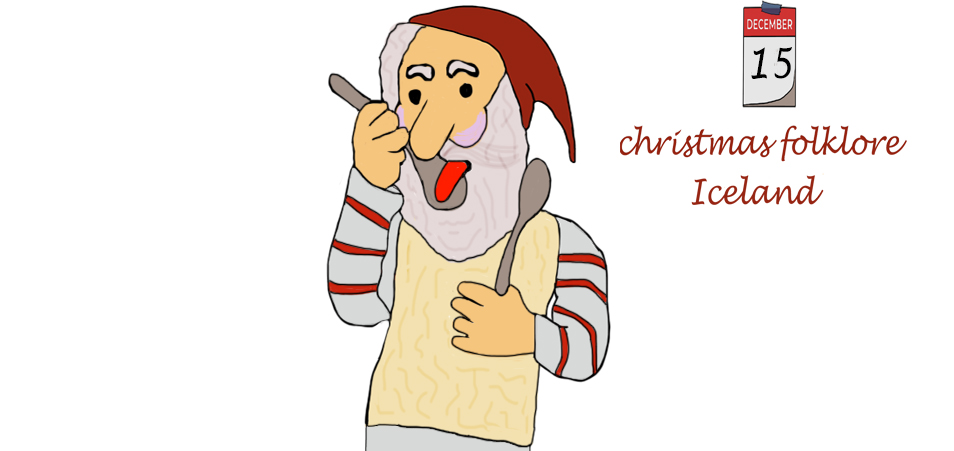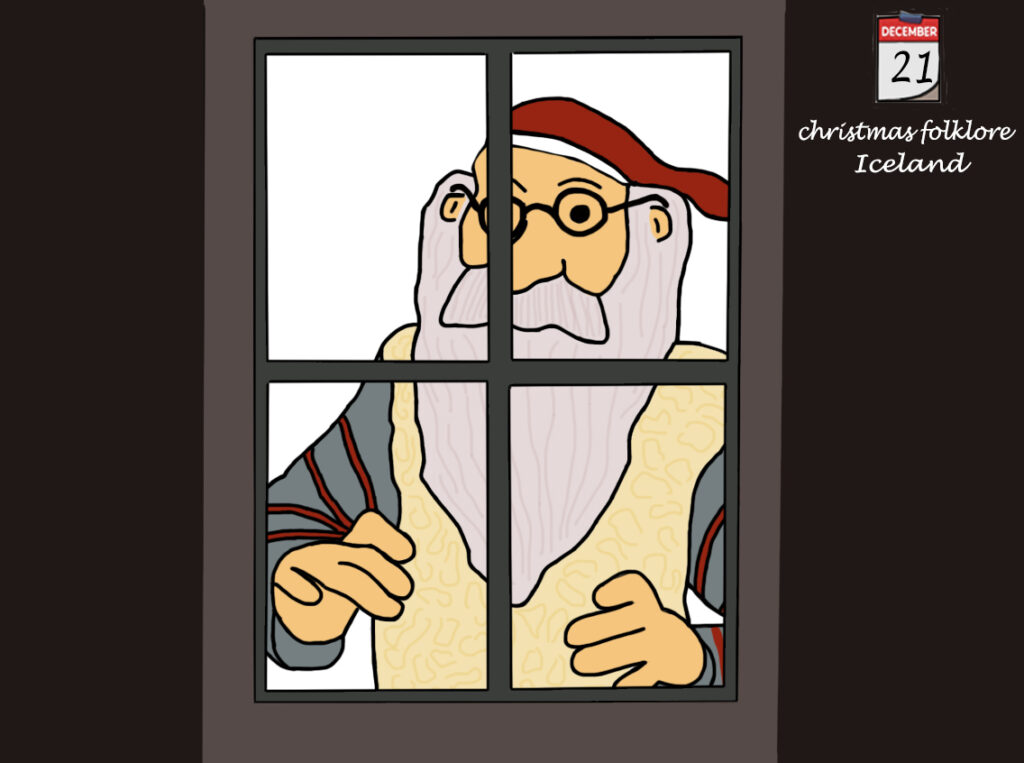A-Z Fairy Folk
Guernsey Gwen has compiled a selection of fairy folk. She has quite an imagination and of course as a member of the fairy folk herself then she often has added information that is just not available anywhere else! This is not an exhaustive list and will be added to from time to time. There are external links to interesting sites for each of the fairy folk but these may change or not work with time – they were informative at the time of publishing.
If you have any fairy folk that you would like to add, then send some details using the contact form.
In general, this is a list of fairly kind fairy folk, (although many are quite mischievious) lots of whom are tree spirits caring for the land; or make a special appearance at Christmas.

She is a woodland fairy who can sometimes be seen in the forest dancing in the mist. You can tell where she has been dancing as a fairy mushroom ring appears.

They are the good fairies, generous and protective of all people. As spirits of trees they take care of the forests.
They are seen walking through the forest trails, resting on the banks of springs and streams. They help injured animals and trees damaged by storms and people who lose their way in the forest. Whenever they wander in villages, they leave gifts at the doors of helpful and kind people.

Auntie of the Starlight (Caribbean)
Auntie is the Caribbean fairy godmother. She looks over the children of this region, helping them when they are in need. A kindly mother figure, she knows exactly what is needed when problems arise. She was particularly helpful to Ebony, the Caribbean cinderella.

Aziza (West Africa)
The Aziza (African) are kind to humans. Living in the forest, they provide good magic for hunters. They are also known to have given practical and spiritual knowledge to humans (including knowledge of the use of fire). The Aziza live in anthills and silk cotton trees.

Befana is a witch who visits children at Christmas in Italy and gives them presents. Put out your Christmas La Calza (stocking) and it will be filled with presents on 6th January.


The Byangoma are human faced birds from Bangladesh. They are wise and tell fortunes.

Babushka (Russia)
The three kings stayed with Babushka on their way to find to the baby Jesus. When they left, she stayed to tidy up first. She made some presents for the baby Jesus set off the next evening to follow the kings and find the baby, but was too late.
Small children look out for her delivering her presents at Christmas.

Brer Rabbit (USA)
Brer Rabbit will never learn! He loves to play jokes, tricks and set traps for his friends – but once in a while, they beat him at his own game!
Br’er is short for brother.

White Boomers (Australia)
In Australia it is midsummer at Christmas and very hot. The reindeer, with their warm fur coats, would just get too hot pulling the sleigh. They make way for male kangaroos called boomers. The names are:
- Jackaroo.
- Curly.
- Bluey.
- Two-Up.
- Desert-Head.
- Snow.

Cherokee Laurel People (North America)
The Little people of the Cherokee tribe are tiny people about the size of pouques ( reaching to your knees). They live in rock caves in the mountains. They are helpful and kind hearted. They love dancing and drumming. They do not like to be disturbed by humans.

Christkindl (Germany)
The Christkindl, or Christ child brings presents to children in many central European countries at the beginning of December. There are also lots of Christkindl markets Germany where you can buy gifts and food.

Cuélebre (Asturias, Spain)
Cuélebre (Asturian) or Culebre (Cantabrian), is a giant winged serpent dragon that lives in a cave, guards treasure and keeps prisoners. Although they are immortal, the cuélebre age, and their scales become thick and impenetrable, and bat wings grow in their bodies. They must eventually flee Asturias and fly to the Mar Cuajada, a paradise located beyond the sea.
They do not usually move, but when they do it, it is in order to eat cattle and people. One could kill the cuélebre by giving them a red-hot stone or a bread full of pins to consume. Its spit it is said to turn into a magic stone, which heals many diseases.
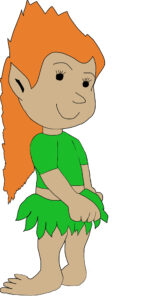

Curupira (Brazil)
The Curupira is a boy with red hair that wanders through the woods using false signs to confuse hunters, woodcutters or anyone who damages their habitat.
He can leave footprints on the forest floor, but as his feet are turned back, he can fool anyone who chases him, making the person think that instead of going he is coming.
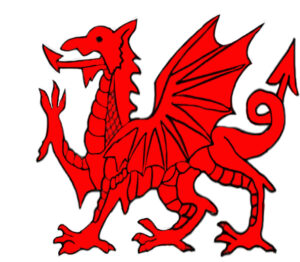
Draig (Cymru, Wales)
Back in time there used to be two dragons, white and red. They fought a battle and the red dragon won and became the symbols of Wales, appearing on the flag.

Easter Chick (No fixed abode)
The Easter Chick arrives at the end of Spring in March or April at Easter time. It is the symbol of Easter and helps to lay chocolate eggs for the Easter bunny to deliver.
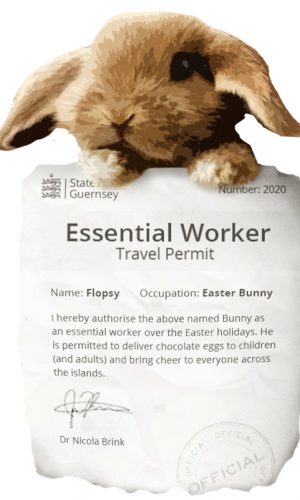
Easter Bunny (No fixed abode).
The Easter Bunny arrives at the end of Spring in March or April at Easter time. It delivers delicious chocolate Easter eggs to small (and big) children and it loves to lay chocolate easter eggs to make trails for young children to follow at places around the UK as well as in people’s gardens.
There are several different Easter bunnies depending on where you are, as unlike Santa, the Easter Bunny can’t travel faster than the speed of light, so he has to have lots of helpers.
During lockdown 2020, the Easter Bunny was given an essential worker travel permit to allow him to travel to the island of Guernsey when the borders were shut due to COVID-19.


Easter Eco Bunnies (No fixed abode)
These bunnies (Lepus Viridis) like to encourage children to paint hard boiled eggs and they only deliver chocolate Easter eggs that have no plastic wrapping. You can enjoy Easter and be kind to the planet.

Fairy Frog (Fairyland)
The fairy frog has appeared in all sorts of stories. He is associated with Jewish fairy tales where Hanina and his wife are rewarded greatly for looking after the frog. Also, you will read about him as the frog prince in the German Grimm’s fairy tales who persuades a princess to kiss him so he can turn into a handsome prince, released from a witches spell.

Father Christmas (Also known as North Pole Santa) Lives in Finland now as the North pole is too unstable now due to ice melting and global warming.

Eco Santa
Eco North Pole Santa lives in Greenland (the ice melted in the North Pole)
Recycles, reduces and reuses
His suit is patched up rather than buying a new one. His trousers are made from an old curtain. His hat is reversible and the lining is an old Guernsey tea towel.
Gives wooden presents to children containing no plastic
His cabin and toy factory run on renewables. Uses reindeer poo as fertiliser and vinegar as weedkiller. Has a pollinator patch in his garden
Has all his vampire devices on a timer
Is a vegetarian most of the time (can’t resist a bacon butty though)

Eco Fiji Santa
Bula (Hello)
Eco Fiji Santa has trousers made from an old sulu. He wears a lei made of hibiscus round his neck. He usually wears shorts and short sleeves but this is a selfie from when he visited Eco North pole Santa.
He has recently had to move to another higher island in Fiji, as his island now floods due to sea level rise. He ferments sugar cane to make alcohol to use to fuel his bure and toy factory.
He travels by outrigger to all the islands when he delivers presents. He really enjoys a lovo on the beach on Christmas day.

Fiji Santa (Fiji, South Pacific)
Bula (Hello)
Fiji Santa is a cousin of the North Pole Santa. It is hot at Christmas time on the South Pacific island of Fiji. Santa dresses in short sleeves and shorts decorated with hibiscus flowers. In this picture he is drinking a local brew called Yaquona from the Kava plant . He is chilled out and has equally chilled out elves who prefer surfing to making toys. Don’t worry though, everyone still gets their presents.

Ghillie Dhu (Alba, Scotland)
The Ghillie dhu is a kindly fairy who lives in the Birch woods and comes out at night. He will find lost children who wander into the country side and return them.

La Gran’mere du Chimquière (Sarnia, Guernsey)
La Gran’mère du Chimquière, the Grandmother of the Cemetery, is a Neolithic stone menhir at the gate of the St. Martin’s parish church, Guernsey. She is over 4000 years old.
She was cut in half by the victorians who didn’t like the attention that she was getting. The parishioners were very cross and got her stuck back together but she was banished just outside the church boundary.
She brings good luck and fertility to newly married couples and it is a tradition to put flowers and coins on her head.
She is very wise and is the head of the fairy folk on the islands.

She is a Welsh water spirit fairy. She lives beneath lakes and rivers. Also called a Lake Maiden or a wife of the lower world.
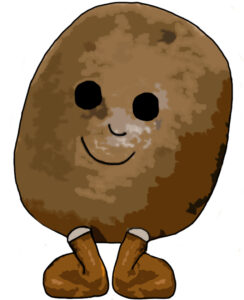
Haggis (Alba, Scotland).
There are two species of Haggis, Lowland and Highland. This is a lowland Haggis. The highland Haggis has different length legs to allow it to walk more easily on the hills.

Humpty Dumpty (Fairyland)
Humpty Dumpty sat on a wall
Humpty Dumpty had a great fall
All the King’s horses and all the King’s men
Couldn’t put Humpty together again.
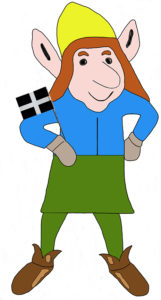
Joan the Wad, Queen of the Cornish Piskies. (Kernow, Cornwall)
Joan is able to turn into a ball of light (the Guernsey word is Feu Boulanger). She is very mischievous and likes to tip over cows. Her husband, the King of the Cornish Piskies is Jack o’ Lantern.

Joulupukki (Finland)
In ancient times the Yule goat used to deliver presents to children at Christmas. However, in modern times, Santa does this but he still uses the name of the Christmas Goat.
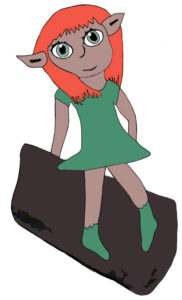
Kijimuna, Japan
They are wood spirits who live in Banyan trees. They have large heads. They are mischievous and like to play tricks on humans.
There is a male Kijimuna in the Disney movie “Stitch” and his magic power is sneezing very powerfully.


Les Korrigans, (Breizh, France)
The Korrigans live in the Brittany area of France. There are lots of different types of Korrigans. The ones that the pouques are friends with are generally mischievous and like to play tricks. They are of similar size to pouques. They live in Dolmens.
There are other Korrigan’s who can be quite mean and substitute Human babies for changelings. Some are also mermaid like sirens who look beautiful but have a very evil nature and kill male humans.


Kwaku Anansi and his wife (Ghana)
The Kwaku Anansi spiders would have fun meeting up with Brer Rabbit as like him, they are just as wiley, naughty and excellent tricksters.
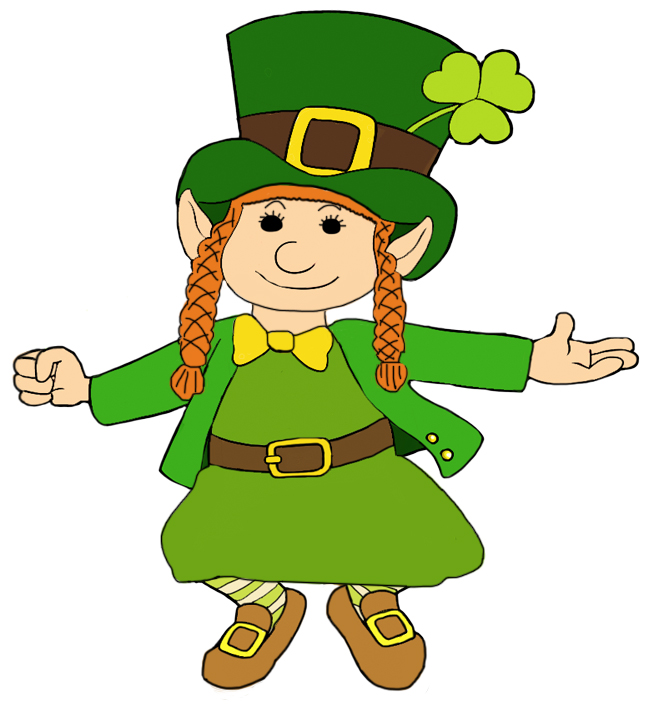

Leprechaun (Eire)
The Leprechaun is generally solitary and quite mischievous. They usually wear a coat and a hat and many of them are shoe makers who have a hidden pot of gold at the end of the rainbow. Humans are always looking for the pot of gold but the Leprechaun makes sure that they don’t find it.
There are no sightings of female Leprechauns, but they do exist, they just don’t show themselves to humans.

Maimoune (Arabia)
The Maimoune has her own story in the 1001 Arabian Nights stories.
Fairy Maimoune is the daughter of Damriat, chief of a legion of genii.
She plays a part in bringing together a handsome prince of Persia and a beautiful princess of China.
She can grant wishes.

Maliwawa Bilby (Northern Australia)
This marsupial creature first appeared as an aboriginal cave painting in the Northern territory of Australia. A magical creature, not much is known about him.
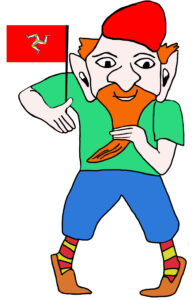
Moonijer Veggey (Ellan Vannin, Isle of Man)
The mooinjer veggey are small people between 50cm and 1 m in height. They wear red caps and green jackets and are most often seen on horseback followed by packs of little hounds of all the colours of the rainbow. They are rather inclined to be mischievous and spiteful.
There are lots of different little people and this picture is of a relative of the Leprechaun. Other fairy folk are the Buggane and the Fenodyree which will get their own section at some point.

Nisse (Norway)
The Nisse are house elves. They will protect the house and children from misfortune. They are very strong. They love porridge.
My good gnome friends, the Nisse will deliver presents to children in Scandinavia on Christmas eve. Don’t forget to put out some porridge for them. You may get a glimpse of the Yule goat if you are lucky.

Ogopogo, (Canada)
Ogopogo is the cousin of the Loch Ness monster. Each of the Great lakes in Canada have their very own Ogopogo, as they are a large family.
They keep out of way of humans who are always trying to spot them.
In days of old, this water creature was quite evil and demanded a live sacrifice to cross the lake. However, the modern day Ogopogos are gentler creatures who keep themselves to themselves and avoid humans.

Olentzero (Basque region)
Olentzero is a giant dressed as a peasant farmer with leather rope shoes, beret and smoking a pipe. He was buried in a house fire after rescuing children. A fairy came and saved him, and he now lives for ever making wooden toys for children in the Basque region, delivering on 24th December.

Peri or Pari (Persia)
A kindly winged fairy who will look after humans but sometimes punishing hunters in the mountains who are disrespectful or waste resources.

Patupaiarehe (Aotearoa, New Zealand)
Patupaiarehe, (from the Maori tradition) have light skin and red hair. They do not have tattoos. They are seldom seen.
Patupaiarehe are afraid of the light, and are only seen at twilight or in the mist. They wear mats and red flax clothes, and can sometimes be heard playing their flutes.

Peter Rabbit, (England)
Peter lives up in the dales of Cumbria. His good friend Beatrix Potter wrote down all the mischievous adventures that he got up to when she lived in Hill house many years ago. He is always trying to eat lettuces from Mr McGregor’s vegetable patch. His brother is Benjamin bunny and his cousins are Flopsy, Mopsy and Cottontail.
Pouques, Guernsey’s naughty pixies.
Pouques are members of the fairy folk in the Channel Islands. Each island has its own colony of pouques who like to live underground. They are very tiny, about the size of toddlers and like to wear hats and green clothes.
Only children can see and hear pouques. These fairy folk are quite mischievous but they do have a kind heart. If you ask them their name, they will always say Jean Petit s they will never tell a human their real name.
Pouques are shape shifters and can change into animals and rocks. Adults can see them as animals, and they are often coloured with green or orange fur or feathers which is a big clue that they have changed shape.




Quinkans (Australia)
Quinkans are spirit people of the land and are split into two tribes.
Imjims are small fat bellied creatures who steal children. Male imjims can bounce very large distances on their willies whilst the female imjims can do the same thing using their breasts.
Timara try and protect children from being kidnapped; they are tall and thin and live in the cracks of the rocks. They are funny and like to play tricks.
You can see aboriginal drawings of the spirits here.

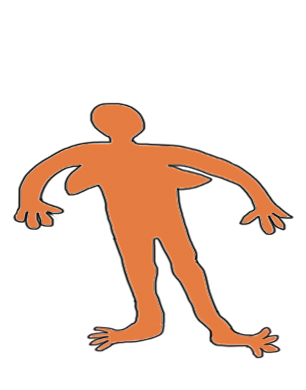


Reindeer (belonging to Santa, North Pole)
When, what to my wondering eyes should appear,
but a miniature sleigh, and eight tiny rein-deer,
with a little old driver, so lively and quick,
I knew in a moment it must be St. Nick.
More rapid than eagles his coursers they came,
And he whistled, and shouted, and call’d them by name:
“Now, Dasher! Now, Dancer! Now, Prancer, and Vixen!
“On, Comet! On, Cupid! On, Donner and Blixen!
“To the top of the porch! to the top of the wall!
“Now dash away! dash away! dash away all!”
As dry leaves that before the wild hurricane fly,
When they meet with an obstacle, mount to the sky;
So up to the house-top the coursers they flew….
A Visit from St. Nicholas by Clement Clarke Moore

Rudolph the red nosed reindeer (North Pole)
With his bright red nose, Rudolph stood out and the other reindeers made fun of him. However, on a foggy Christmas morning, Rudolph saved the day by showing Santa the way using his red nose as a bright light. The other reindeer then welcomed him.

Sinterklass (Nederlands)
My dear friend Sinterklaas delivers presents to children in Europe. In the Netherlands he delivers on the evening of 5th December but in the rest of Europe is comes on 6th December.
His big red book tells him if children deserve a present.
He has elf helpers called Piets.
Don’t forget to leave your shoe near the chimney or heating boiler with a carrot or hay for his white horse.

Sugar Plum Fairies. (From around the World)
You will find the sugar plum fairy dancing in the ballet by Tchaikovsky called “The Nutcracker.”
The Sugar Plum Fairy is the ruler of the Land of Sweets. She welcomes the Nutcracker Prince and his love Clara to her land and orders the festivities.
These nine fairies met to celebrate the nine ladies dancing on the ninth day of Christmas.

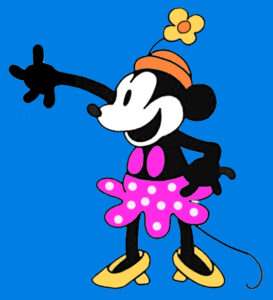
Steamboat Mickey Mouse and Minnie Mouse
They are both Disney fairy folk and they can usually only have Disney adventures. However this is the great great grandfather of the modern day Mickey mouse born in 1928 and he is now able to have adventures of his own that are not controlled by Disney.
The film he is starring in here is called Steamboat Willie and was one of the first ever Disney animations. His girlfriend in the film is called Minnie Mouse.
The plot: Mickey is piloting a steamboat when Captain Pete comes to the bridge and throws him off. They stop to pick up cargo. Minnie just misses the boat and Mickey uses the crane to grab her. She drops her sheet music of “Turkey in the Straw” and a goat eats it. With help from Mickey, she cranks the goat’s tail, and it plays the tune. Mickey accompanies on percussion, until Pete comes down and puts a stop to it, putting Mickey to work peeling potatoes.

Christmas Spider (Ukraine)
A poor but hardworking widow once lived in a small hut with her children. They could not afford to decorate the Christmas tree. The next morning they opened the windows and rays of sunlight touched the webs spun by the Christmas spider and turned them into gold and silver. This is how we got tinsel.

Tio de Nadal (Catalonia)
Tio is made from a wooden log. Catalan children look after him very well at Christmas. He has the nickname of the “pooping log” because he rewards children for looking after him by pooping sweets on Christmas day. They have to lift the blanket to find the sweets.

Trolde (Denmark)
They are tiny creatures who live in live in isolated area of mountains. They are rarely helpful to humans. There are lots of different types of troll and some are very ugly. There is a famous story is about how one rather obnoxious troll tried to stop the three Billy Goats gruff crossing the bridge to the greener grass on the other side.

Tomte (Sweden)
The Tomte and Nisse are from the same family and they are both House elves looking after farms. The Tomte especially like horses.
There are different dress codes for the different types of tomtes. The ones living in the stables with the animals wear mostly grey clothes while the ones in the main house are dressed more neatly, combining some colour with the grey, such as blue or dark green.

Wandjina (Western Australia)
They are rain and cloud spirits from the Aboriginal tradition. Around their head is lightning strikes and they don’t often have a mouth. The heart is shown in the middle of the body.
Witches of the Channel Islands, UK
These witches below are very modern and won’t be found in any other books.
Olden tales of fairy folk of the channel islands have been extensively archived by
Guernsey Folk Lore, by Edgar MacCulloch
The Folklore of Guernsey, by Marie de Garis
and in a summary by F. Bihet called The Channel Island: Les Petits Faîtchieaux



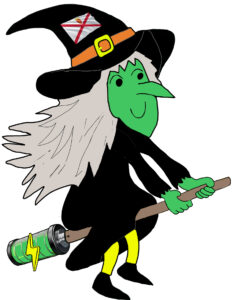


Finland has 13 santas. They live up the mountain with their mother Grýla. Each day starting from 12th December, one of the Yule lads will come down from the mountain and play tricks. They will give a present for good children who leave a shoe on their windowsill.



